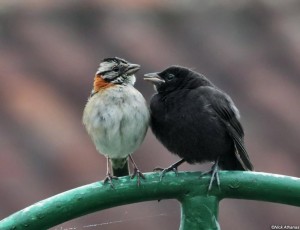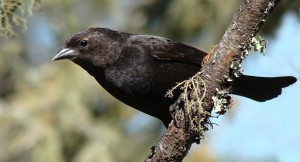Week 43 – 7 May 2017:
Peck, Peck, Peck
There was a time when ministers would include examples of animal behavior in their sermons in order to show parishioners a proper way to behave. See how the lioness protects her cubs against all threats, even at the risk of her own life. Behold the robin that continues to brood her chicks through the worst of storms. What a mistake that was! We now realize that in the struggle to survive and reproduce, animals are willing to engage in some pretty awful behaviours, none of which should be used as a model for human actions.
For example, while parents of most bird species are fully dedicated to the task, members of other species choose to shunt the responsibilities of parenthood onto others. An individual that lays its eggs in the nest of another bird is described as a brood parasite. A facultative brood parasite can, and probably will, make a nest and care for some of its own young, but will attempt to leave an additional egg or two in the nest of a neighbour. Far more sophisticated is the obligate brood parasite who has no intention of ever building a nest, relying completely on the nests of members of other species in which to lay their eggs.
Natalia Cossa and her colleagues at Niversidad de Buenos Aires studied the behaviours of two species of obligate brood parasite in Argentina. As parasites, Shiny Cowbirds are generalists, known to lay their eggs in the nests of over 250 bird species. In contrast, Screaming Cowbirds are specialists, parasitizing only Baywings over much of their range.
As with many other species of brood parasite, when these cowbirds come to a host nest, they peck and puncture one or more eggs of their host. Cossa and her coworkers sought to determine why the birds would do this. They considered the possibility that if the host’s clutch was already completed, the hosts would hatch before the cowbird chick and outcompete it. There would be little point in a cowbird laying a parasitic egg if there was little chance that it would survive. If that is the case, then cowbirds might puncture the host’s eggs to force it to renest, giving the cowbird and opportunity to lay in the new nest.
Alternatively, could the cowbird be seeking to reduce the competition? By puncturing one or two host eggs, a cowbird might ensure that there would be abundant food for its own chick.
The study involved female Shiny and Screaming cowbirds taken into captivity. They were presented with nests with either one egg, implying that the clutch was not yet complete, or four eggs, implying that the clutch was already complete. Some presentation nests contained small eggs from House Wrens, others with larger and most robust Chalk-browed Mockingbird eggs, or the eggs of Shiny Cowbirds which were of intermediate size but were even more puncture resistant.
Cossa et al. found that eggs were equally likely to be punctured in completed clutches as in incomplete clutches, suggesting that the goal of the cowbird was not to cause the host to abandon its efforts and renest. When the nest contained four eggs, indicative of a completed clutch, the parasitic female did not destroy all of the host’s eggs. The researchers felt that this behaviour was most consistent with the idea that these cuckoos puncture eggs in order to reduce competition for their own chicks.
Birds may be beautiful beyond compare, but they can also be devious.
Cossa, N. A., D. T. Tuero, J. C. Reboreda and V. D. Fiorini. 2017. Egg pecking and puncturing behaviors in Shiny and Screaming cowbirds: effects of eggshell strength and degree of clutch completion. Behav. Ecol. Sociobiol. 71:60.
Photo credits: Shiny cowbird chick being raised by a Rufous-collared Sparow, © Nick Athanas – www.hbw.com; Screaming cowbird © Cesar Dario Lins – www.flickr.com & neotropical.birds.cornell.edu



